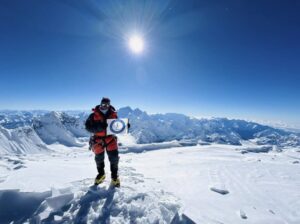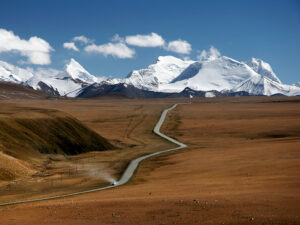Ali Akbar Sakhi used to train in the mountains around his home in Kabul. “When I die, I want to be buried here,” he told his hiking mates, half joking, about that part of the Hindu Kush range that he loved so much. Little did he know that he would end his days on a much higher mountain, K2. To bring Sakhi home, his widow persevered until she got the help she needed.
The operation to recover Sakhi’s body from 7,200m sets a series of important precedents. It is the first time rescuers have recovered a body from such altitude on K2, a 100% local team completed the operation, and its leader, Abid Sadpara, is willing to devote his career to high mountain rescues in Pakistan.
The background

Ali Akhbar Sakhi on his last climb on K2.
Ali Akbar Sakhi was 34 years old and determined to become the first climber from Afghanistan to summit K2. “Ali Akbar Sakhi wanted to see a free Afghanistan, he loved his country and was a great supporter of female empowerment. He helped female Afghan climbers to achieve their goals and prove they are capable of anything if given a chance,” his widow Karima told ExplorersWeb.
Karima says that Sakhi’s motivation only increased after the Taliban took power and banned women from work and education. “He wanted to get his voice heard by waving the Afghan flag from the summit of K2 and crying out to the world what Afghans could do if they regained freedom and peace.”
On a tight budget, Sakhi paid $40,000 to climb on O2 and a porter supported him. Yet, during the summit push, something went terribly wrong as they climbed from Camp 2 to Camp 3.
Sakhi and the porter, progressing slowly, were caught in a storm. Eventually, Sakhi stopped the porter and tried to continue to Camp 3. The camp was only 200 vertical meters above and a big team from Sakhi’s outfitter Karakoram Expeditions was there, waiting to continue higher the following day.
As we reported in a detailed feature story, no help came from Camp 3 and Sakhi spent the night in the open, alone. Members of Sakhi’s own team who had given up on the summit found him next to the ropes. Reportedly, they gave Sakhi O2, but the Afghan climber died soon after. Pakistani climbers Naila Kiani, Sirbaz Khan, and Arshad were on their way up from Camp 2 when they saw Sakhi collapse. They reached him but there was nothing they could do except perform last rites, cover his face, and move him away from the ropes.
This year, climbers heading to K2’s summit passed Sakhi’s body below Camp 3. Thankfully, for the last time.
Karima Sakhi’s plea
“I wrote a request letter to the Chief General of the Pakistan Army telling my story, asking for help to clear up the facts and bring my husband’s remains back to Afghanistan,” Karima Sakhi told ExplorersWeb.
It worked. The Pakistan Army decided to help with a retrieval operation. The Askari pilots would airlift the body from Base Camp, but someone had to bring it down from where it lay. They looked around and found the right man for the task near Skardu.

The recovery team comprised six members, necessary to perform the task successfully and guarantee the rescuers’ safety. Photo: Hassan Sadpara Rescue Team
Abid Sadpara is the son of Hassan Sadpara, a well-known climber from the village that was also home to Ali Sadpara (who died on a winter K2 climb), and his son (current 14×8,000’er climber) Sajid Sadpara.
Abid Sadpara had started his own expedition outfitting company under the name of his father two years ago. But as he got involved in the K2 recovery operation, he registered a new branch of the company focused on rescues, he told ExplorersWeb. There is no rescue company in Pakistan.
We asked Abid Sadpara for details about the mission, with translation help from Naila Kiani, the Pakistani climber who found Sakhi last year and met the rescue team near Base Camp this year.
The recovery
The Pakistan Army contacted Abid Sadpara to bring Sakhi’s body down.
“I drafted a recovery mission plan and with the Army’s agreement picked the best climbers from around Skardu, all of them previous 8,000’ers summiters, to collaborate in the rescue,” Abid Sadpara said. He built his team with Sadiq Sadpara, Ali Musa, Arif Sadpara, Murad Ali Shagri, and Abdin Shagri. Enough climbers to perform the rescue successfully and as safely as possible.
“Prior to heading for K2, the team members participated in meetings and specific training on how to bring the body down, based on the information we had,” Sadpara added. It was a key factor in the success of the operation.
“The weather was very bad, it was very windy,” Sadpara recalled. “The most difficult part was abseiling the body down House’s Chimney, which is wide enough only for one person. The team really struggled to get past it, but they managed to get the remains to Camp 1,” Sadpara said. “Then, on the following day, we all returned to Base Camp from there we called the Army helicopters.”
The pilots took the body to a hospital in Skardu where staff prepared the remains for transfer to Kabul, where Sakhi was finally buried. Ironically, Karima didn’t attend the funeral, and she won’t be able to visit her husband’s grave. Before climbing K2, Sakhi moved his family to the US, fleeing Taliban-ruled Afghanistan.
After the mission concluded, Army personnel checked Sakhi’s down suit. Inside the breast pocket, they found the Afghan flag. It is the same little flag that Naila caught as it flew from Sakhi’s failing hands last year, in the last moments of his life. Sirbaz Khan put the flag in the deceased climber’s pocket when he performed the last rites.
How about the other bodies on the mountain?
The recovery team completed the job in six days, slightly longer than the time agreed with the Army, but they refused to leave the job undone.
“As far as we know, this was the first rescuer/recovery mission of this kind in Pakistan,” Sadpara told ExplorersWeb. “We have learned a lot from the experience; if we can count on the Army and get the support of Pakistan’s government, we can definitely help with other bodies on K2, like John Snorri and Muhammad Hassan, if the family wishes.”
Abid Sadpara has already sent a proposal to rescue Hassan’s body, located at 8,200m in the traverse under the Great Serac. As for Snorri’s body, also right on the ascent route at the Bottleneck, that would depend on the family.
Teaming up with Ali Sadpara (who also died), Snorri died attempting winter K2 in 2021. His body was only found the following summer. Previously, Snorri’s widow, Linda Snorri, made clear that she wouldn’t put anyone’s life at risk trying to move her husband down. As for Ali Sadpara’s remains, his son Sajid climbed the mountain that summer and personally buried his father deep in the snow. “The mountain is now my father’s burial place,” Sajid told AFP.
For Abid Sadpara, rescues on K2 have become a purpose. “My father’s dream was to have a rescue team in Pakistan, many people have died on K2 and we do not have a professional rescue patrol,” he said.
K2 is a technically hard, steep mountain, even when climbed on the normal route. Climbers who perished on the mountain are left to rest where they fell or moved only a few meters away. Only some of those who passed on the lower sections (typically below House’s Chimney) have been recovered.
The recent operation, performed above House’s Chimney and the Black Pyramid, is a significant first step. Yet rescue management on Pakistan’s 8,000’ers still has a long way to go. Recovery teams must be numerous and skilled, which requires official support and significant funding.
The final goal should be to have people on the mountain able and willing to rescue climbers in trouble, in time to save their lives.
No peace for the widow
Sakhi’s widow is incredibly grateful to the rescuers and the Pakistani Army. “They helped me, they are heroes of Pakistan; my family and I will be always grateful,” she said. Yet, she is far from finding peace. The good news of having her husband’s remains properly buried has only re-ignited her rage against Sakhi’s outfitter whom she claims left her husband to die.
“Mirza Ali [owner of Sakhi’s outfitter Karakorum Expeditions] said it was impossible to get his body down. Now my question for him is: How impossible was it when a proper team only needed six days?” Karima Sakhi said.

Ali Akbar Sakhi’s widow, Karima Sakhi. Photo: Anthrowcircus.com
Karima Sakhi fiercely criticized Karakorum Expeditions when the accident happened, remarking that there was a big team just 200m above her sick husband, and no one went down to help while he was alive all night.
Mirza Ali’s sister, Samina Baig, was in that team at Camp 3, supported by the bulk of the company’s staff as she raced to be the first Pakistani woman to summit K2 (a feat she achieved two days later). Sakhi’s widow believes the team prioritized supporting Baig instead of risking her attempt’s success to help a sick climber. Using her late husband’s profile on social media, she has never stopped demanding Karakorum Expeditions be investigated. You can read Karima Sakhi’s latest X (formerly Twitter) posts here.






